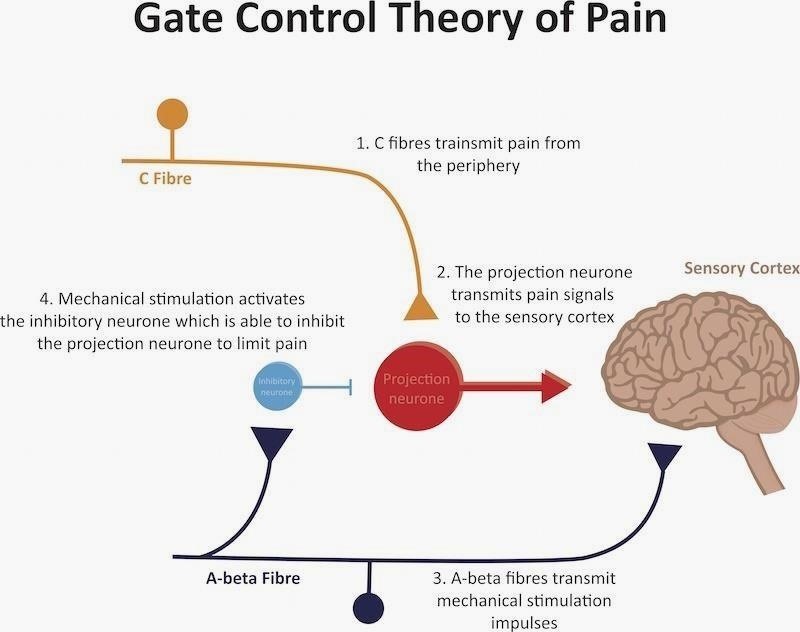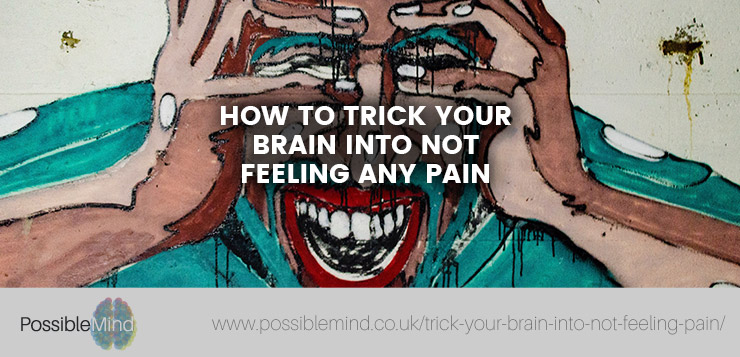Pain is, for the most part, unavoidable when you stub your toe, break your arm, or cut your finger open. It’s instantaneous and, in some cases, long-lasting, but it only feels as bad as you want it to. Yes, that’s right—that pain is all in your head.
Now I’m not saying that pain is an imaginary symptom of an injury—pain is definitely real. It’s basic physiology. But pain is produced by the brain, and there are a few ways you can trick your brain into making those unpleasant physical feelings go away—without using pain medication.
How Your Brain Deals with Pain
As Johns Hopkins University neuroscience professor David Linden shares with NPR, the pain you feel when hurt is controlled and directed by your brain’s circuitry. As the brain filters all of the information coming from your sensory nerves, it focuses on certain bits and pieces in particular.
Linden explains, “The brain can say, ‘Hey that’s interesting. Turn up the volume on this pain information that’s coming in.’ Or it can say, ‘Oh no — let’s turn down the volume on that and pay less attention to it.'”

Your brain processes pain both physically, where it notes the location and intensity, and emotionally, where it dictates your reaction. For example, when you feel a sharp, stabbing pain shoot down your leg, that’s your brain’s interpretation of physical intensity. When you find yourself shrieking out loud in response, that’s your brain’s emotional response. So, what does this all have to do with pain management? If you know what, exactly, sets off your brain’s emotional responses to injury, you can better control what you feel—or what you think you feel.
Overload Yourself with Positivity to Lessen the Hurt
It might sound ridiculous, particularly when you’re suffering from pain that seems insurmountable, but positive thoughts and emotions can actually counteract those bad feelings.
When you’re feeling nothing but negativity, like fear and insecurity, you create the perfect breeding ground for pain. The “weaker,” or more negative, your mind is, the more you feel the full effects of whatever is ailing you. Conversely, when you feel safe, secure, and comfortable—yet encounter pain—you respond with less physical feeling.

Surprisingly, just as pain can build over time and make you feel even weaker, positive thoughts grow and compound as well, according to recent researchpublished in American Psychologist. The more you tweak your perspective and focus on the positive rather than giving in to your negative tendencies, the stronger your emotional resiliency becomes.However, you need to overwhelm yourself with positivity to reap its pain-relieving benefits, according to Dr. Barbara Fredrickson, a leading scholar in the area of positive psychology and author of Positivity. Because your negative bias is both strong and inherent, your brain requires three positive experiences to help you begin thinking in a kinder way. Put this into practice to prepare for your next painful encounter by thinking about every situation from a positive point of view.
Distract Your Brain from Feeling the Pain
Your brain filters determine how, and to what extent, you feel pain. So in order to control what you feel, you need to find a way to manage what it is your brain’s sensors pick up.
That’s what researchers at Brown University studied. When examining the frequency of brain waves in response to physical sensations, the team found that attempts to ignore feelings and senses cause low-frequency rhythms—which do the blocking—to increase, not only in the area of the brain that deals with a certain body part in question, but in the area of the brain that ignores distractions.
When asked to focus on a specific hand or foot, the study’s participants responded to light taps from the researchers on different body parts—but not physically. Instead, their brains began increasing low-frequency rhythms as they struggled to fight the response of the body part being touched. While the brain worked to ignore the distracting touch on one body part, it began working to filter out that physical, sensory information.

This means, according to the researchers, that you can teach your brains to filter out pain, but perhaps only pain that is chronic. The repeated messages from a spot on your body filled with pain dull over time as the brain become used to receiving them, lessening the emotional and physical sensation.
If you want to train your brain to forget about pain, you don’t exactly need to develop a chronic condition. Instead, you simply need to become familiar with the sensations so your brain recognizes them. Much like the familiar habit of snapping rubber bands or pinching wrists to break habits, the more of one kind of pain you encounter, the less it will hurt.
Practice Mindful Meditation
Meditation is the art of sitting still and letting the mind run wild. With just a few minutes of quiet, unmoving silence, you can do more than relax and unwind; you can retrain your brain to feel less pain, according to a 2011 study on “mindful” meditation.
Researchers examined participants who practiced mindful mediation, for a period of meditation during which they performed body and breath work. When participants focused on their thoughts and tiny, imperceptible feelings during the meditation, they were able to control their bodies’ responses to external stimuli. So, when struck with sudden pain, individuals were able to keep their brains calm and non-responsive.

Relieving pain may not be an instantaneous act, but with time and practice you can adapt your brain to handle every bump, cut, and injury with ease. Focus in on your body, and it can become numb in the most necessary situations.
To learn more please visit mind-hacks.wonderhowto.com
If you like this post you will also enjoy:
- Power of Hope and Prayer In Improving Toothache Pain.
- How Mental Imagery Manages Pain.
- The Buddhist Monk Who Controlled Pain and Suffering.
- Virtual Reality Helps Distract Kids from Painful Medical Procedures.






